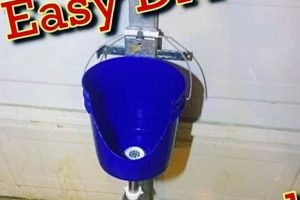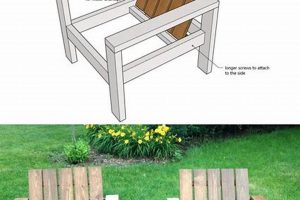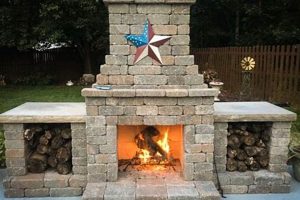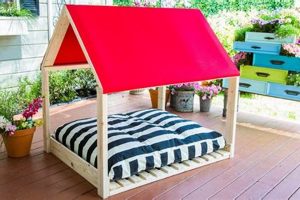The creation of a designated open-air canine waste management zone involves constructing a specific area within a yard or outdoor space designed to encourage and facilitate urination and defecation by domestic dogs. This constructed space typically incorporates materials like gravel, artificial turf, or mulch, and is often enclosed to contain the dog within the intended area. The purpose is to provide a consistent and manageable location for pet waste, simplifying cleanup and minimizing impact on other areas of the property. For example, a homeowner might construct a fenced-in area filled with pea gravel in a corner of their backyard to serve this function.
The establishment of such a zone offers numerous advantages, including improved yard hygiene, reduced risk of lawn damage from urine, and simplified waste disposal. Historically, pet owners have struggled with the environmental impact and aesthetic concerns associated with pet waste scattered throughout their properties. Concentrating waste in a single location facilitates responsible disposal, such as composting or bagging for municipal waste collection. Furthermore, consistent use of a designated area can train dogs to relieve themselves in a predictable location, minimizing accidents in other parts of the yard or inside the home.
Considering the benefits of hygiene, lawn protection, and waste management, the following discussion will delve into specific materials suitable for construction, drainage considerations, methods for training a dog to utilize the space, and strategies for maintaining the area to ensure cleanliness and longevity.
Construction and Maintenance Tips
The successful implementation and long-term utility of a dedicated canine relief space hinges upon careful planning, appropriate material selection, and diligent maintenance practices. Adherence to the following guidelines will contribute to a hygienic, functional, and aesthetically pleasing outcome.
Tip 1: Select Drainage-Promoting Substrates: Gravel, pea stone, or artificial turf with perforations facilitate efficient drainage, preventing the accumulation of stagnant water and minimizing odors. Avoid materials like dense clay soil, which retain moisture and create unsanitary conditions.
Tip 2: Establish Perimeter Containment: A physical barrier, such as low fencing or edging, defines the designated area and prevents the unintentional spread of waste to surrounding areas. This containment also aids in training the dog to associate the enclosed space with elimination.
Tip 3: Incorporate Waste Removal Protocols: Implement a consistent waste removal schedule, utilizing appropriate tools such as pooper scoopers and biodegradable waste bags. Regular removal minimizes odor and discourages insect infestation.
Tip 4: Implement Periodic Disinfection: Regular cleaning with a pet-safe disinfectant eliminates bacteria and reduces odor. The frequency of disinfection should be adjusted based on usage and environmental conditions.
Tip 5: Strategic Location Selection: Locate the area in a readily accessible location for the dog, ideally near a door used for outdoor access. This encourages consistent use and minimizes the likelihood of accidents indoors.
Tip 6: Consider a Washable Surface: Hard surfaces are easily washed down. Using a pressure washer from time to time is important.
Tip 7: Implement a Training Regimen: Employ positive reinforcement techniques to train the dog to consistently use the designated area. Reward successful elimination with praise and treats.
By implementing these tips, the designated area will function as a sanitary and convenient solution for managing pet waste, protecting the surrounding landscape, and simplifying maintenance routines.
The next section will address potential challenges encountered during construction and maintenance, and offer solutions to ensure the continued effectiveness of this outdoor system.
1. Material Selection
Material selection constitutes a foundational element in the successful design and functionality of a designated outdoor canine relief area. The chosen materials directly impact drainage, odor control, ease of cleaning, and the overall attractiveness of the space. Prioritizing appropriate materials is crucial for creating a hygienic and manageable zone.
- Drainage Capacity
The drainage capabilities of the selected material are paramount. Materials such as gravel, pea stone, or specialized artificial turf allow for rapid water permeation, preventing the accumulation of stagnant liquid waste. This reduces odor and inhibits bacterial growth. Conversely, impermeable surfaces require additional drainage solutions to mitigate these issues. Example: Utilizing a compacted clay base will inevitably result in poor drainage, necessitating the implementation of a subsurface drainage system.
- Odor Absorption and Retention
Certain materials exhibit properties that either absorb or repel odors. Highly porous materials may retain odors, requiring more frequent cleaning and disinfection. Non-porous materials or those treated with odor-resistant coatings are preferable. For example, cedar chips, while aesthetically pleasing, may retain urine odor over time, unlike smooth river rocks, which are easier to clean and disinfect.
- Cleanability and Maintenance
The ease with which a material can be cleaned and maintained is a significant consideration. Smooth, non-absorbent surfaces facilitate the removal of solid waste and allow for effective disinfection. Rough or porous surfaces are more challenging to clean, potentially harboring bacteria and requiring more intensive maintenance. Example: Artificial turf designed for pet use typically incorporates antimicrobial properties and is easily rinsed, while natural grass requires regular mowing and waste removal to prevent odor buildup.
- Durability and Longevity
The selected material must withstand exposure to the elements, including sunlight, rain, and temperature fluctuations. Durable materials resist degradation and maintain their functionality over time, minimizing the need for frequent replacement. For example, concrete pavers offer greater longevity and resistance to wear compared to wood chips, which decompose and require periodic replenishment.
The selection of materials for a canine waste management zone necessitates a comprehensive understanding of their individual properties and their combined impact on drainage, odor control, cleanability, and longevity. Careful consideration of these factors ensures the construction of a functional, hygienic, and aesthetically acceptable area for pet waste management.
2. Drainage System
The efficacy of any designated outdoor canine relief area is inextricably linked to the design and implementation of an appropriate drainage system. Inadequate drainage results in unsanitary conditions, exacerbates odors, and compromises the long-term usability of the designated space. A well-designed drainage system is, therefore, a fundamental component.
- Subsurface Drainage Layer
A subsurface layer of gravel or crushed stone facilitates the rapid percolation of liquids away from the surface. This layer prevents the accumulation of standing water, mitigating odor and hindering bacterial proliferation. The depth and composition of this layer must be appropriate for the anticipated volume of liquid waste and the permeability of the underlying soil. For example, a clay-rich soil requires a thicker, more permeable drainage layer than sandy soil.
- Surface Material Permeability
The surface material must allow liquids to pass through to the subsurface drainage layer. Impermeable surfaces, such as concrete without drainage apertures, negate the benefits of an underlying drainage system. Permeable materials like pea gravel, shredded rubber, or specialized artificial turf enable efficient drainage while providing a comfortable surface for the animal. Considerations should include the material’s ability to resist clogging from solid waste and its ease of cleaning.
- Slope and Grade Considerations
A slight slope or grade is crucial to direct liquids towards a designated drainage point, such as a French drain or connection to a municipal stormwater system (where permissible and compliant with local regulations). This slope prevents pooling and ensures that liquids are effectively removed from the area. The degree of slope must be sufficient to promote drainage without creating an unstable or uncomfortable surface for the dog.
- Collection and Disposal Mechanism
A designated collection point for drained liquids is essential for responsible waste management. This may involve a simple gravel pit for percolation into the ground (subject to soil conditions and local regulations), a French drain system leading to a safe discharge point, or a connection to a municipal sewer system (with appropriate permits and approvals). The chosen disposal method must comply with all applicable environmental regulations and prevent contamination of surrounding areas.
The integration of these drainage facets is critical for maintaining a hygienic and odor-free canine relief area. By carefully addressing subsurface drainage, surface permeability, slope, and waste collection, one can create a system that effectively manages liquid waste, promotes a clean environment, and ensures the long-term viability of the designated space.
3. Area Containment
Area containment is a critical component influencing the success and effectiveness of any designated outdoor canine relief area. It establishes the physical boundaries of the designated zone, influencing both the animal’s behavior and the maintenance requirements of the surrounding environment. The absence of adequate containment can lead to unintended consequences, such as the dispersal of waste beyond the intended zone, increased cleaning efforts, and potential damage to surrounding landscaping.
Effective area containment can manifest in various forms, ranging from simple low fencing to more elaborate enclosed structures. The specific type of containment should align with the dog’s size, breed, and temperament, as well as the overall design aesthetic of the outdoor space. For instance, a small, low-energy breed may only require a short, decorative fence to delineate the area, while a larger, more active breed may necessitate a taller, more robust enclosure to prevent escape. Real-world examples include homeowners utilizing repurposed garden edging, constructing low wooden fences, or employing commercially available pet containment systems. These physical barriers provide a clear visual cue to the dog, reinforcing the designated elimination area and reducing the likelihood of accidents elsewhere. The containment also serves to protect surrounding plants and lawns from the potentially harmful effects of dog urine and feces, thereby preserving the aesthetic value of the landscape.
In summary, area containment is indispensable for establishing a defined and manageable zone for canine waste elimination. Its implementation simplifies maintenance, protects the surrounding environment, and facilitates the training process. While the specific design and materials may vary based on individual needs and preferences, the fundamental principle of creating a clear and secure boundary remains paramount for the overall success of the designated outdoor relief area. A failure to properly address area containment effectively undermines the functionality of any other measures implemented within the system.
4. Waste Management
Effective waste management is paramount for the successful implementation and long-term viability of any dedicated outdoor canine relief area. Proper handling and disposal of canine excrement mitigate environmental concerns, reduce odor, and maintain the overall hygiene of the surrounding environment. The subsequent points outline essential facets of waste management as they pertain to dedicated outdoor canine relief systems.
- Regular Waste Removal
Consistent and timely removal of solid waste is the cornerstone of effective waste management. Accumulated feces contribute to odor, attract pests, and can pose health risks. The frequency of removal should correspond to the size and usage of the designated area, but daily removal is generally recommended. Appropriate tools, such as pooper scoopers and designated waste receptacles, should be readily available and employed diligently. Real-world examples include homeowners emptying waste receptacles into sealed garbage bags for municipal waste collection or utilizing composting systems designed for pet waste, adhering to local regulations and guidelines.
- Liquid Waste Mitigation
Canine urine presents a distinct set of challenges for waste management. Its high nitrogen content can damage vegetation and contribute to unpleasant odors. A well-drained surface, as previously discussed, is essential for mitigating the impact of liquid waste. In addition, incorporating materials with odor-absorbing properties, such as zeolite or activated charcoal, into the substrate can further reduce odor. Regular rinsing of the designated area with water can also help to dilute and flush away residual urine. Some pet owners opt for specialized enzymatic cleaners designed to break down urine compounds and neutralize odors. It’s crucial to ensure that any cleaning products used are pet-safe and environmentally friendly.
- Disposal Methods and Compliance
The method of waste disposal must comply with all applicable local regulations and environmental standards. Direct burial of canine waste is generally discouraged due to potential groundwater contamination. Municipal waste collection is a common and convenient option, provided that waste is properly bagged and sealed. Composting is a viable alternative, but requires a dedicated composting system and adherence to specific guidelines to ensure proper decomposition and pathogen control. Certain municipalities may offer pet waste-specific composting programs or facilities. It is incumbent upon pet owners to research and comply with local regulations regarding pet waste disposal to ensure responsible environmental stewardship.
- Sanitization and Disinfection
Periodic sanitization and disinfection of the designated area are essential for maintaining hygiene and controlling the spread of bacteria and parasites. Pet-safe disinfectants should be used to clean surfaces and neutralize potential pathogens. The frequency of sanitization will depend on the usage of the area and environmental conditions. In hot and humid climates, more frequent sanitization may be necessary. Regular rinsing with water after disinfection helps to remove any residual disinfectant and prevents potential irritation to the dog. Careful attention to sanitization practices minimizes the risk of disease transmission and contributes to a healthier environment for both pets and humans.
These multifaceted approaches to waste management directly influence the cleanliness, odor control, and environmental impact of a dedicated outdoor canine relief system. Implementing these strategies contributes significantly to the long-term sustainability and overall success of the designated area.
5. Training Protocols
The successful integration of a designated canine relief area is predicated on the establishment and consistent application of effective training protocols. The mere construction of a specific area does not guarantee its utilization by the dog; training is essential to establish the intended association between the location and the act of elimination. The cause-and-effect relationship is clear: consistent training protocols directly influence the dog’s behavior and, consequently, the functionality of the constructed relief area. The lack of such protocols invariably leads to inconsistent usage, undermining the hygienic and practical benefits of the dedicated space.
Training methods typically involve positive reinforcement techniques. For example, upon witnessing the dog urinating or defecating within the designated area, immediate verbal praise and the provision of a small treat serve to positively reinforce the desired behavior. Consistency is paramount; rewarding the behavior only when it occurs within the designated zone reinforces the association. Other techniques include leading the dog to the area at predictable elimination times (e.g., after waking up, after meals) and using a specific cue word or phrase to prompt elimination. Should the dog eliminate outside the designated area, a neutral or mildly corrective response (e.g., a firm “no”) can discourage the undesirable behavior, provided it is coupled with immediate redirection to the intended location. This underscores the importance of supervision and timely intervention.
The practical significance of understanding and implementing these training protocols is multifaceted. It minimizes accidents within the home and in other areas of the yard, contributing to improved sanitation and reduced cleaning requirements. It also fosters a more predictable and manageable elimination routine for the dog, reducing anxiety and promoting a more harmonious relationship between the animal and its owner. Ultimately, the effectiveness of a designated canine relief area is directly proportional to the diligence and consistency with which training protocols are applied. Failing to prioritize this aspect renders the physical construction of the area largely ineffective.
Frequently Asked Questions
The following questions address common concerns and misconceptions regarding the creation and maintenance of a dedicated outdoor space for canine waste elimination. The intent is to provide clarity and guidance based on established best practices.
Question 1: What is the minimum recommended size for this area?
The size depends on the breed and size of the dog, but generally, an area of at least 4 feet by 4 feet is advisable for smaller breeds. Larger breeds may require a space of 6 feet by 6 feet or larger to allow sufficient room for comfortable elimination.
Question 2: Is artificial turf a suitable material, and if so, what type is recommended?
Artificial turf is a viable option, provided it is specifically designed for pet use and incorporates antimicrobial properties. It must be permeable to allow for drainage. Turf intended for athletic fields is generally unsuitable due to its dense construction and lack of drainage.
Question 3: How often should the area be cleaned and disinfected?
Solid waste should be removed daily. The frequency of disinfection depends on usage and environmental conditions, but weekly disinfection is generally recommended. More frequent disinfection may be necessary during warmer months or periods of heavy use.
Question 4: Can a canine waste composting system be safely used in a residential setting?
Canine waste composting is permissible, provided that the system is specifically designed for pet waste and operated according to manufacturer instructions and local regulations. Improper composting can lead to incomplete decomposition and the spread of pathogens. Verify local guidelines before implementation.
Question 5: What measures can be taken to minimize odor emanating from the area?
Effective odor control strategies include regular waste removal, a well-drained substrate, the use of odor-absorbing materials (e.g., zeolite), and periodic disinfection with pet-safe products. Ensuring adequate sunlight exposure can also help to naturally reduce odor.
Question 6: How can the area be protected from attracting insects and pests?
Regular waste removal is the primary defense against insects and pests. Maintaining a clean and dry environment discourages breeding. The use of pet-safe insecticides or insect repellents around the perimeter of the area can provide additional protection. Consult with a veterinarian regarding safe and effective pest control options.
Adhering to these guidelines helps ensure the creation and maintenance of a safe, hygienic, and environmentally responsible outdoor canine relief area.
The subsequent section will address advanced design considerations and potential challenges encountered during the construction and maintenance of dedicated outdoor relief systems.
DIY Outdoor Dog Potty Area
This exposition has detailed the critical aspects of creating a responsible and effective system. Key elements, from material selection and drainage considerations to waste management protocols and training methodologies, are all necessary to achieve a functional, hygienic, and environmentally conscious open-air canine waste area. The absence of attention to any one of these areas can compromise the system’s efficacy and undermine its intended benefits.
The creation of a designated outdoor waste area represents a commitment to responsible pet ownership and environmental stewardship. Pet owners must carefully consider local regulations, prioritize hygiene, and implement consistent maintenance practices to ensure long-term success. The collective effort of pet owners adopting these measures will undoubtedly contribute to cleaner communities and a more sustainable environment for all.







